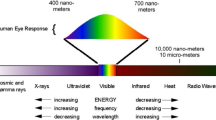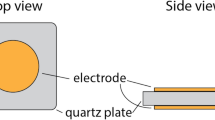Abstract
This work aims at improving the sensitivity of a surface plasmon resonance (SPR) sensor with the BK7 prism, silver/gold (Ag/Au) bimetallic films, 2D materials tungsten disulfide (WS2), and MXene (Ti3C2Tx) under angular interrogation technique. The proposed SPR sensor is a free space structure using the Kretschmann configuration to stimulate surface plasmons (SPs). The finite-difference time-domain (FDTD) method is used to analyze the optical behavior of the proposed SPR sensor. The thickness of the bimetallic layers and the number of layers of 2D materials are optimized to obtain maximum sensitivity for various sensing medium refractive indices ranging from 1.33 to 1.335 RIU. The maximum sensitivity of 348 deg/RIU is obtained with a thickness of 33 nm Ag, a thickness of 15 nm Au and with monolayer WS2, and four layers of Ti3C2Tx MXene at 633 nm. This excellent performance of the proposed structure makes it suitable for detecting biomolecules and other analytes.










Similar content being viewed by others
Data Availability
All data included in this paper are available upon request by contact with the contact corresponding author.
References
Maier SA (2007) Plasmonics: fundamentals and applications. Springer
Kretschmann E, Raether H, Notizen (1965) Radiative decay of non radiative surface plasmons excited by light. Z Naturforsch A 23(12):2135–2136
Otto A (1968) Excitation of nonradiative surface plasma waves in silver by the method of frustrated total reflection. Z Phys 216:398–410
Wu L et al (2018) Few-layer Ti3C2Tx MXene: a promising surface plasmon resonance biosensing material to enhance the sensitivity. Sens Actuators B, Chem 277:210–215
AlaguVibisha G et al (2020) Sensitivity enhancement of surface plasmon resonance sensor using hybrid configuration of 2D materials over bimetallic layer of Cu–Ni. Opt Commun 463(125337)
Raghuwanshi SK, Kumar M, Jindal SK, Kumar A, Prakash O (2020) High-sensitivity detection of hazardous chemical by special featured grating-assisted surface plasmon resonance sensor based on bimetallic layer. IEEE Trans Instrum Meas 69(7):5072–5080
Srivastava A, Verma A, Das R, Prajapati YK (2020) A theoretical approach to improve the performance of SPR biosensor using MXene and black phosphorus. Optik 203(163430)
Xu Y, Ang YS, Wu L, Ang LK (2019) High sensitivity surface plasmon resonance sensor based on two-dimensional MXene and transition metal dichalcogenide: a theoretical study. Nanomaterials 9(2):1–11
Rakhshani MR, Mansouri-Birjandi MA (2018) Engineering hexagonal array of nanoholes for high sensitivity biosensor and application for human blood group detection. IEEE Trans Nanotechnol 17(3):475–481
Ghodrati M, Mir A, Farmani A (2020) Carbon nanotube field effect transistors-based gas sensors. In: Nanosensors for Smart Cities. Amsterdam, The Netherlands: Elsevier, pp 171–183. https://doi.org/10.1016/B978-0-12-819870-4.00036-0
Dolatabady A, Asgari S, Granpayeh N (2018) Tunable mid-infrared nanoscale graphene-based refractive index sensor. IEEE Sensors J 18(2):569–574
Naderi A, Ghodrati M (2018) An efficient structure for T-CNTFETs with intrinsic-n-doped impurity distribution pattern in drain region. Turkish J Electr Eng Comput Sci 26(5):2335–2346. https://doi.org/10.3906/elk-1709-180
Abbasi M, Soroosh M, Namjoo E (2018) Polarization-insensitive temperature sensor based on liquid filled photonic crystal fiber. Optik 168:342–347
Naderi A, Ghodrati M (2017) Improving band-to-band tunneling in a tunneling carbon nanotube field effect transistor by multi-level development of impurities in the drain region. Eur Phys J Plus 132(12):510
Naderi A, Ghodrati M (2018) Cut off frequency variation by ambient heating in tunneling p-i-n CNTFETs. ECS J Solid State Sci Technol 7(2):M6–M10
Parandin F, Heidari F, Rahimi Z, Olyaee S (2021) Two-dimensional photonic crystal biosensors: a review. Opt Laser Technol 144(107397)
Khani S, Hayati M (2021) An ultra-high sensitive plasmonic refractive index sensor using an elliptical resonator and MIM waveguide. Superlattices Microstruct 156(106970)
Naderi A, Ghodrati M, Baniardalani S (2020) The use of a Gaussian doping distribution in the channel region to improve the performance of a tunneling carbon nanotube field-effect transistor. J Comput Electron 19(1):283–290
Ghodrati M, Farmani A, Mir A (2019) Nanoscale sensor-based tunneling carbon nanotube transistor for toxic gases detection: a first-principle study. IEEE Sensors J 19(17):7373–7377
Farmani A, Zarifkar A, Sheikhi MH, Miri M (2017) Design of a tunable graphene plasmonic-on-white graphene switch at infrared range. Superlattices and Microstruct 112:404–414
Ghodrati M, Farmani A, Mir A (2021) Non-destructive label-free biomaterials detection using tunneling carbon nanotube based biosensor. IEEE Sensors J 21(7):8847–8854
Vafapour Z, Troy W, Rashidi A (2021) Colon cancer detection by designing and analytical evaluation of a water-based THz metamaterial perfect absorber. IEEE Sensors J 21(17):19307–19313
Ghodrati M, Mir A, Naderi A (2020) New structure of tunneling carbon nanotube FET with electrical junction in part of drain region and step impurity distribution pattern. AEU-Int J Electron Commun 117(153102)
Ghodrati M, Mir A, Naderi A (2021) Proposal of a doping-less tunneling carbon nanotube field-effect transistor. Mater Sci Eng A: B 256(115016)
Mohamadi A, Seifouri M, Karami R, Olyaee S (2021) Proposal of a high-Q biosensor using a triangular photonic crystal filter. Opt Quantum Electron 53(471):1–12
Khozeymeh F, Razaghi M (2021) Sensitivity and intrinsic limit of detection improvement in a photonic refractive-index sensor. Optik 247(167844)
Hajshahvaladi L, Kaatuzian H, Danaie M (2020) A high-sensitivity refractive index biosensor based on Si nanorings coupled to plasmonic nanohole arrays for glucose detection in water solution. Opt Commun 502(127421)
Mozaffari MH, Ebnali-Heidari M, Abaeiani Gh, Moravvej-Farshi MK (2018) Designing a miniaturized photonic crystal based optofluidic biolaser for lab-on-a-chip biosensing applications. Org Electron 54:184–191
Zhao X, Huang T, Ping PS, Wu X, Huang P, Pan J, Wu Y, Cheng Z (2018) Sensitivity enhancement in surface plasmon resonance biochemical sensor based on transition metal dichalcogenides/graphene heterostructure. Sensors 18(7):2056
Kumar R, Pal S, Prajapati YK, Saini JP (2020) Sensitivity enhancement of MXene based SPR sensor using silicon: theoretical analysis. Silicon 13:1887–1894
Kumar R, Pal S, Verma A, Prajapati YK, Saini JP (2020) Effect of silicon on sensitivity of SPR biosensor using hybrid nanostructure of black phosphorus and MXene. Superlattices Microstruct 145(106591)
Yue C, Lang Y, Zhou X, Liu Q (2019) Sensitivity enhancement of an SPR biosensor with a graphene and blue phosphorene/ transition metal dichalcogenides hybrid nanostructure. Appl Opt 58(34):9411–9420
Shushama KN, Rana MDM, Inum R, Hossain MDB (2017) Sensitivity enhancement of graphene coated surface plasmon resonance biosensor. Opt Quantum Electron 49(381)
Dong N et al (2015) Optical limiting and theoretical modelling of layered transition metal dichalcogenide nanosheets. Sci Rep 5(14646)
Nurrohman DT, Chiu NF (2020) Surface plasmon resonance biosensor performance analysis on 2D material based on graphene and transition metal dichalcogenides. ECS J Solid State Sci Technol 9:115023
Singh MK, Pal S, Prajapati YK, Saini JP (2020) Sensitivity improvement of surface plasmon resonance sensor on using BlueP/MoS2Heterostructure and antimonene. IEEE Sensors Lett 4(7):1–4
Author information
Authors and Affiliations
Contributions
MG, AM, AF: software, data curation, investigation, conceptualization, methodology, writing — review and editing. AM, AF: validation, data curation, writing — original draft.
Corresponding author
Ethics declarations
Consent for Publication
All authors of this paper agree to publish our theoretical research.
Competing Interests
The authors declare no competing interests.
Additional information
Publisher's Note
Springer Nature remains neutral with regard to jurisdictional claims in published maps and institutional affiliations.
Rights and permissions
About this article
Cite this article
Ghodrati, M., Mir, A. & Farmani, A. Sensitivity-Enhanced Surface Plasmon Resonance Sensor with Bimetal/ Tungsten Disulfide (WS2)/MXene (Ti3C2Tx) Hybrid Structure. Plasmonics 17, 1973–1984 (2022). https://doi.org/10.1007/s11468-022-01685-w
Received:
Accepted:
Published:
Issue Date:
DOI: https://doi.org/10.1007/s11468-022-01685-w




